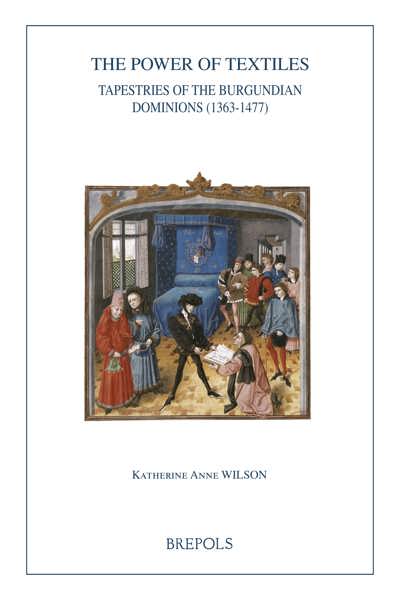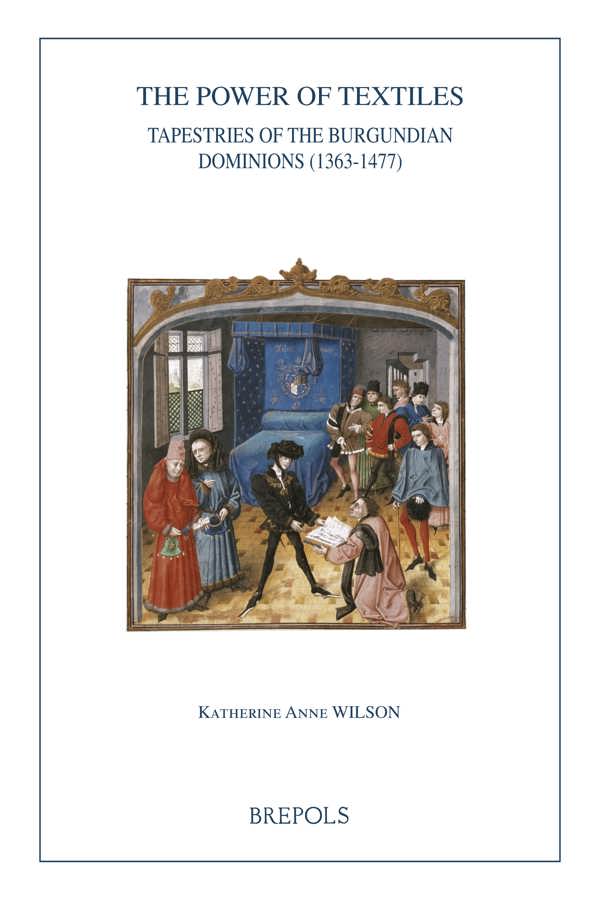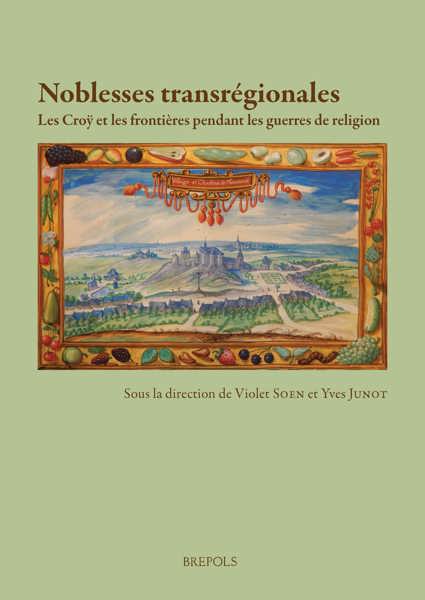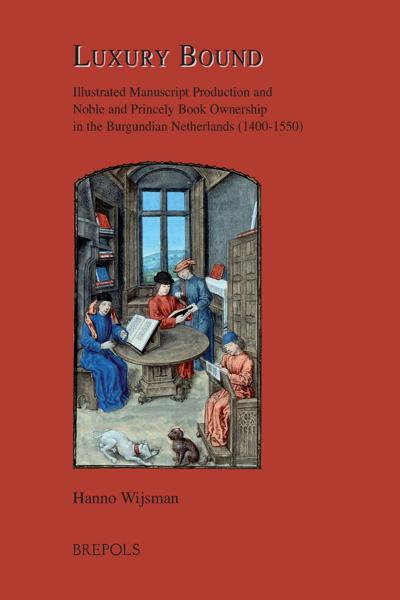
- Pages: xii + 221 p.
- Size:156 x 234 mm
- Illustrations:28 b/w, 2 tables b/w.
- Language(s):English
- Publication Year:2018
- € 80,00 EXCL. VAT RETAIL PRICE
- ISBN: 978-2-503-53393-3
- Paperback
- Available
- € 80,00 EXCL. VAT RETAIL PRICE
- ISBN: 978-2-503-55701-4
- E-book
- Available
The power of textiles in the Burgundian Dominions, spinning webs between city and court c. 1363-1477.
« (…) l’ouvrage de Katherine Anne Wilson remplit parfaitement le contrat qu’elle s’est imposé : livrer une synthèse claire, présentant de très nombreuses perspectives de recherches, apportant des éléments de réponse dans la majorité des cas et en répondant parfaitement à certaines. Plus encore, la recherche ici présente souligne avec une grande réussite la complexité de la diplomatie bourguignonne, de même que la grande hauteur de vue des ducs quant à l’avenir de leurs territoires et à la manière dont la politique du don sert les intérêts de ces derniers. En cela, Katherine Anne Wilson livre un ouvrage de référence tant sur le savoir-faire que sur le génie politique des ducs Valois de Bourgogne et, à n'en pas douter, ce travail fera date. » (Guillaume Bureaux, dans Histara, 30/04/2019)
“Her work offers an important contribution to the history of textile production and consumption, and enriches our understanding of social status and power during the Burgundian Dominions.” (Erika E. Hess, in French Review, 93/1, 2019, p. 222)
Katherine Anne Wilson is Senior Lecturer in Medieval History at the University of Chester. Her research interests lie in understanding the relationship between social and cultural change, and shifting patterns in the use of material culture in the later Middle Ages. She has worked and published on the circulation of tapestry and luxury goods of the Burgundian Netherlands as well as the biographies of their producers and consumers.
Textiles were used as markers of distinction throughout the Middle Ages and their production was of great economic importance to emerging and established polities. This book explores tapestry in one of the greatest textile producing regions, the Burgundian Dominions, c. 1363-1477. It uses documentary evidence to reconstruct and analyse the production, manufacture, and use of tapestry. It begins by identifying the suppliers of tapestry to the dukes of Burgundy and their ability to spin webs between city and court. It proceeds by considering the forms of tapestry and their functions for urban and courtly consumers. It then observes the ways in which tapestry constructed social relations as part of gift-giving strategies. It concludes by exploring what the re-use, repair, and remaking of tapestry reveals about its value to urban and courtly consumers. By taking an object-centred approach through documentary sources, this book emphasises that the particular characteristics of tapestry shaped the strategies of those who supplied it and the ways it performed and constructed social relations. Thus, the book offers a contribution to the historical understanding of textiles as objects that contributed to the projection of social status and the cultural construction of political authority in the Burgundian polity.
Introduction: The Power of Textiles.
This chapter sets out the contribution of the book to the history of textiles and the building of power in the Burgundian Dominions. It sets out its broader contribution to two areas of historiography. First, it considers what this study of tapestry contributes to the understanding of consumption in the later Middle Ages. It highlights the historiographical significance of this studies argument that the urban context shaped patterns of consumption, rather than emulation of the court. It explores the historiographical significance of seeking to understand the motivations of consumers, here through the idea that objects can be ‘actors’, and that objects and people can be interdependent actors. It establishes the historiographical significance of focusing on the ‘materiality’ of the textile as a factor shaping the strategies of its suppliers and the treatment of the textile. Second, it examines what tapestry can illuminate regarding scholarly debates on the construction and maintenance of Burgundian power by members of its dynasty and the elites of their territories. It sets out the well-known history of the Burgundian dynasty to emphasise that their recent and precarious position required regular statements of their authority and their right to independence – requirements that this study suggests tapestry helped to fulfil through the creation of portable architectural spaces and items with special qualities for gift-giving strategies. It notes the recent trend to depict the dukes as dependent on urban centres – a tendency supported here by the evidence for their reliance on trusted urban suppliers of luxury objects and their accessing of specialist urban markets and personnel, and gift-gifting to urban elites. The sources for the study are introduced, the ducal accounts, inventories and published and unpublished testaments. Finally, the art-historical development of tapestry scholarship is reviewed to demonstrate the value of the documentary approach pursued in this book.
Chapter 1: Spinning Networks and Spreading Risk
Based primarily on the Burgundian ducal accounts this chapter investigates the suppliers and servicers of tapestry to the Burgundian household. It underlines the Burgundian household’s dependence on specialist urban markets and its need to tap into urban specialist suppliers of tapestry by reconstructing their urban careers and biographies. Ducal authority and power was in part maintained by the ability of the ducal household to plug themselves into these suppliers and to forge relationships with these individuals, relationships that often lasted for generations. It considers how these suppliers built on their urban reputations to manage the risk of commissions by spinning networks between several noble households, creating personal ties with the ducal administration and procuring positions in the Burgundian household. Finally it argues that the risk of supplying tapestry and the need for the maintenance of their reputation drove tapissiers to retain a close involvement in the manufacture, upkeep, and transport of their commissions, and that it was the intrinsic quality of the product that shaped these strategies.
Chapter 2: Flexible Architecture. The Warp and Weft of Urban and Courtly Residences
This chapter investigates the wide variety of tapestry furnishings available to urban dwellers and the Burgundian household. It sets out that these textiles were in part a product of the wider circulation, exchange and diversification in objects across Europe during the Middle Ages. It suggests that individuals responsible for furnishing settings, whether they were urban inhabitants or the garde de la tapisserie of the Burgundian household, exploited the materiality of textiles as a portable environment, using them to create spaces as the need arose, whether political, dynastic or domestic. Immovable urban and courtly residences ‘framed’ these textile constructions and presented ‘theatres’ with temporarily furnished stages on which managed meetings presented images of their inhabitants. The notion of ‘theatre’ serves as the framework for the second and third parts of the chapter. It examines the ways in which the inhabitants of Dijon and Tournai used their textiles to ‘act’ and ‘perform’ within urban ‘theatres’. It also considers the ways in which the Burgundian dynasty used their textiles to furnish themselves with a royal reputation, albeit not always successfully. However, the performance of tapestry was not fixed and tapestry could also reflect the fragmented nature of the Burgundian polity, the gulf between duchy and regnum and the uncertainty of urban careers and family position.
Chapter 3: The Fabric of Social Relations
This chapter demonstrates how tapestry helped construct and maintain the ‘fabric of social relations’ between members of the Burgundian dynasty, other members of European nobility, and occasionally members of their household. Documentary references to tapestry as a gift demonstrates it as an ‘object in motion’ and illuminate the wider historical context of the exchange. The chapter reconstructs the historical circumstances and social bonds created by the exchanges of tapestry by the Burgundian household. Central to the chapter is the materiality of tapestry and tapestry as an active agent in the process of gift exchange. Why was tapestry offered as a gift on these particular occasions? What set this type of textile apart from the other cloths and other objects that formed part of the Burgundian household’s repertoire of gift-giving objects? It argues that tapestry’s ability to carry large or small-scale visual programmes meant that the ways in which givers could load them with messages and the ways in which receivers could view them were flexible. Thus they kept alive diplomatic interventions, expressed the asymmetry between European ruling households, performed as visible reminders of the urban specialists and expertise to which the Burgundian household had access, and bound ducal servants and ambassadors ever tighter to the Burgundian enterprise.
Epilogue: Repair, Reuse and Remaking, Constructing the Burgundian Polity
The epilogue draws together the understanding of the power of tapestry through a consideration of the evidence for the repair, reuse, and remaking of tapestry in the ducal accounts, ducal inventories, and household inventories. A focus on these issues brings us back to the materiality of tapestry and the importance of the intrinsic characteristics of the textile in the eyes of medieval consumers, be they an urban elite of Dijon, a garde de la tapisserie, or a member of the Burgundian dynasty. It demonstrates that the ability of tapestry to be resized, reshaped, retain memories, and be repaired through time was a reason why it attracted medieval owners. It also underscores that the interdependence between the dukes and their subjects was achieved culturally as well as financially and institutionally. This study of tapestry is thus a starting contribution to the cultural construction of later medieval states and their inhabitants; on this occasion through the power of textiles.
Glossary of Textile Terminology
The glossary includes the main terms used throughout the book. It demonstrates an example of the term as included in the ducal accounts, inventories or testament and then includes further information that will help the reader to grasp the full meaning of the word or term.




